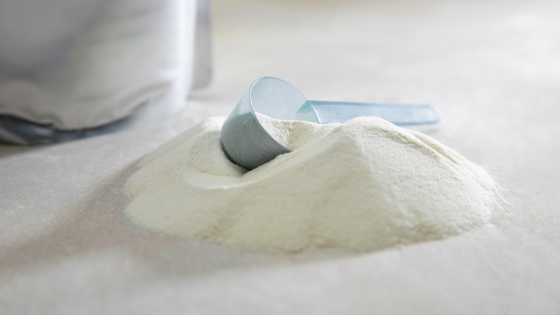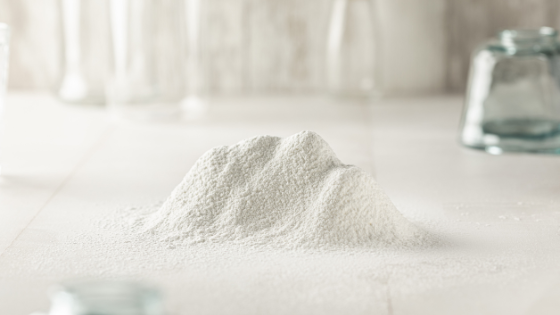
The benefits of dairy ingredients for maintaining bone health
The consumption of dairy products (milk, yoghurt, cheese) is generally associated with maintaining good bone health at any age. Above all, the calcium content of dairy products is emphasised, not only in terms of quantity, but also in terms of quality, due to its high bioavailability. However, beyond calcium, other milk ingredients have been the subject of scientific studies and are also worth highlighting with regard to bone health : proteins and lactose.
During the growth and development process, bones grow and increase in size (in length and thickness) through the combined action of accretion and resorption. The growth process stops at the end of adolescence and from then on, bone mass will only decrease. It is therefore essential to maintain bone mass throughout life by means of a healthy diet based on specific dairy ingredients.
Milk proteins and bone health : many studies and the position of learned societies
Proteins fulfil many physiological functions in the body. First, proteins provide the only source of nitrogen for the body, and it is largely based on this that the nutritional reference values (NRV) have been defined in France and abroad2. Proteins also play a structural role in the body, in muscle tissue, of course, but also in the bone matrix1.
Beyond their role in the bone matrix, proteins play a key role in preventing fractures in adulthood and during the ageing process. The 2018 recommendations issued jointly by the International Osteoporosis Federation and the European Society for Clinical and Economic Aspects of Osteoporosis, Osteoarthritis and Musculoskeletal Diseases (ESCEO), highlight this sometimes-overlooked aspect of protein11. Reviewing the scientific literature, both societies highlight the correlation between high protein intake and high bone mineral density, lower bone resorption, and reduced risk of hip fractures. The two learned societies go further on protein’s mechanisms of action. By increasing the levels of insulin-like growth factor 1 (IGF-1) and decreasing the levels of parathyroid hormone (PTH), protein supplementation is seen to play a protective role for bones in adults, and especially in the elderly11.
Proteins play a key role in preventing fractures in adulthood and during the ageing process
There are several studies specifically on milk proteins and their relevance to bone health. These include both observational studies and controlled clinical studies. A first observational study from 2014 positively correlated milk protein intake with bone mineral density in people over 50 10. In line with this study, another observational study linked high milk protein intake with better bone strength and bone microstructure8. Existing clinical studies complement these results concerning milk proteins. In a first study from 2001, Aoe and colleagues were able to show that women aged 29 on average, supplementing with whey protein for six months achieved a significant increase in bone mineral density. The authors credited whey protein with the ability to inhibit osteoclast activity 4. A few years later, the same research group obtained similar results for postmenopausal women. Supplementing with whey protein for six months also increased the participants’ bone mineral density3. In fact, these clinical results confirm the conclusions of preclinical studies that already suggested the ability of certain milk proteins (both caseins and whey) to modulate the function of osteoblasts and osteoclasts5.
Study linked high milk protein intake with better bone strength and bone microstructure
Finally, dairy proteins can have a beneficial impact on bone physiology indirectly, by modulating calcium absorption. The ability of dairy proteins to chelate minerals, particularly calcium, has been extensively examined in vitro by several researchers6. Consequently, the addition of dairy proteins allows for better absorption of calcium from the alimentary bolus and contributes to better bone mineralisation.

Lactose : an indirect effect on bones via calcium
Like milk proteins, lactose can act indirectly on bone health by helping to absorb calcium from the alimentary bolus. This capacity of lactose is well known and has been well documented in numerous preclinical studies carried out in the 1980s and 1990s. These preclinical studies showed that lactose improved the absorption of calcium, whatever the source of the calcium. Two absorption mechanisms were highlighted as being aided by lactose : passive transport throughout the small intestine, and increased diffusion through the jejunum (Hodges et al., 2019).
Lactose can act indirectly on bone health by helping to absorb calcium from the alimentary bolus
Micellar casein : a source of both protein and calcium
Micellar caseins, due to their structure and biological roles, are known to bind and provide a significant amount of calcium (De Kruif et al., 2003). Micellar caseins are therefore excellent dairy ingredients for bone health providing not only calcium for bone mineralisation, but also milk proteins which, as mentioned above, have a positive effect on bone physiology.

General conclusion
Milk contains many ingredients that, when consumed regularly, contribute to good bone health. Milk proteins, which are already well known for their significant nutritional quality, have a well-documented, positive impact on bones and are also recommended by learned societies. Other active ingredients such as lactose and micellar caseins should be highlighted. Incorporating these ingredients into foods is therefore strategic for preserving bone capital and contributing to consumers’ general good health.
Sources:
[1] Anses (2013), https://www.anses.fr/fr/content/les-protéines
[2] Anses (2016), Actualisation des repères du PNNS : élaboration des références nutritionnelles. https://www.anses.fr/fr/system/files/NUT2012SA0103Ra-2.pdf
[3] Aoe, S., Koyama, T., Toba, Y., Itabashi, A. & Takada, Y. (2005). A controlled trial of the effect of milk basic protein (MBP) supplementation on bone metabolism in healthy menopausal women. Osteoporosis International, 16(12), 2123-2128. https://doi.org/10.1007/s00198-005-2012-3
[4] Aoe, S., Toba, Y., Yamamura, J. I., Kawakami, H., Yahiro, M., Kumegawa, M., … & Takada, Y. (2001). Controlled trial of the effect of milk basic protein (MBP) supplementation on bone metabolism in healthy adult women. Bioscience, biotechnology, and biochemistry, 65(4), 913-918. https://doi.org/10.1271/bbb.65.913
[5] Bu, T., Zheng, J., Liu, L., Li, S. & Wu, J. (2021). Milk proteins and their derived peptides on bone health: Biological functions, mechanisms, and prospects. Comprehensive Reviews in Food Science and Food Safety, 20(2), 2234-2262. https://doi.org/10.1111/1541-4337.12707
[6] Burrow, K., Young, W., McConnell, M., Carne, A. & Bekhit, A. E. D. (2018). Do dairy minerals have a positive effect on bone health? Comprehensive reviews in food science and food safety, 17(4), 989-1005. https://doi.org/10.1111/1541-4337.12364
[7] De Kruif, C. G. & Holt, C. (2003). Casein micelle structure, functions and interactions. In Advanced dairy chemistry – 1 proteins (pp. 233-276). Springer, Boston, MA.
[8] Hodges, J. K., Cao, S., Cladis, D. P. & Weaver, C. M. (2019). Lactose intolerance and bone health: the challenge of ensuring adequate calcium intake. Nutrients, 11(4), 718. https://doi.org/10.3390/nu11040718
[9] Rizzoli, R., Biver, E., Bonjour, J. P., Coxam, V., Goltzman, D., Kanis, J. A., … & Reginster, J. Y. (2018). Benefits and safety of dietary protein for bone health – an expert consensus paper endorsed by the European Society for Clinical and Economical Aspects of Osteoporosis, Osteoarthritis, and Musculoskeletal Diseases and by the International Osteoporosis Foundation. Osteoporosis International, 29(9), 1933-1948. https://doi.org/10.1007/s00198-018-4534-5















